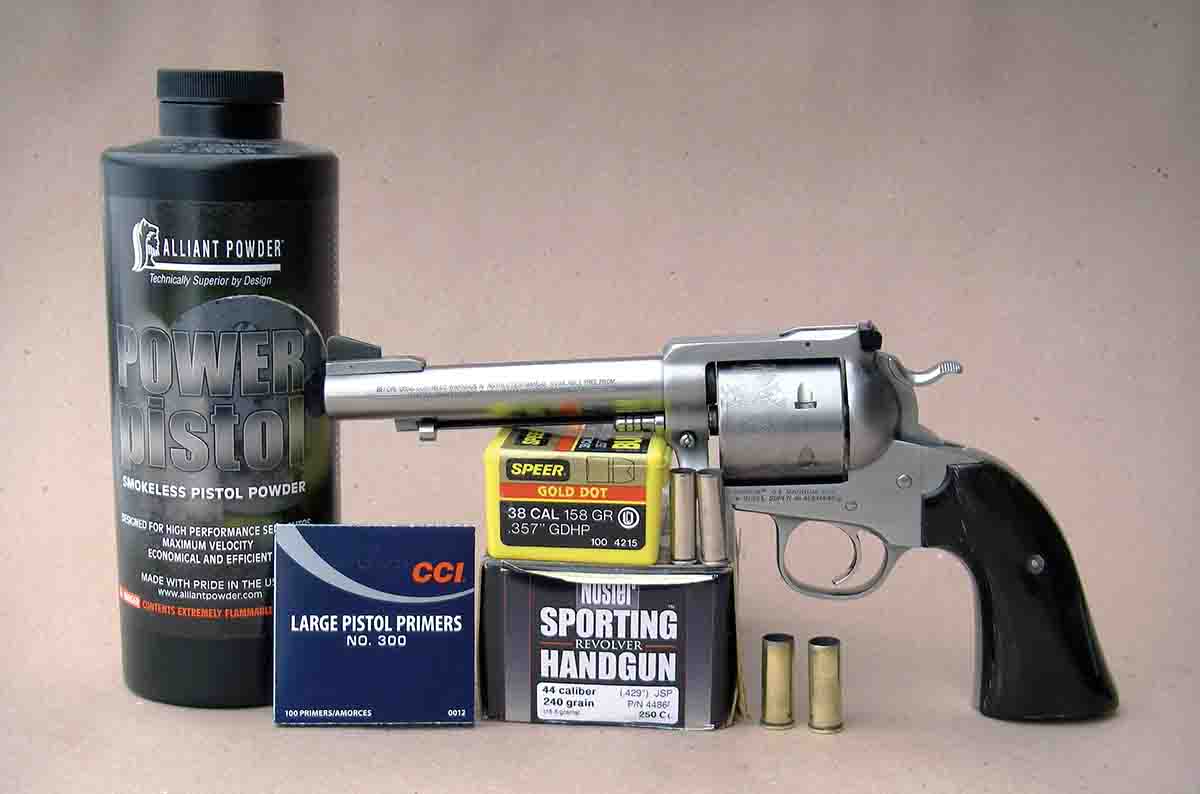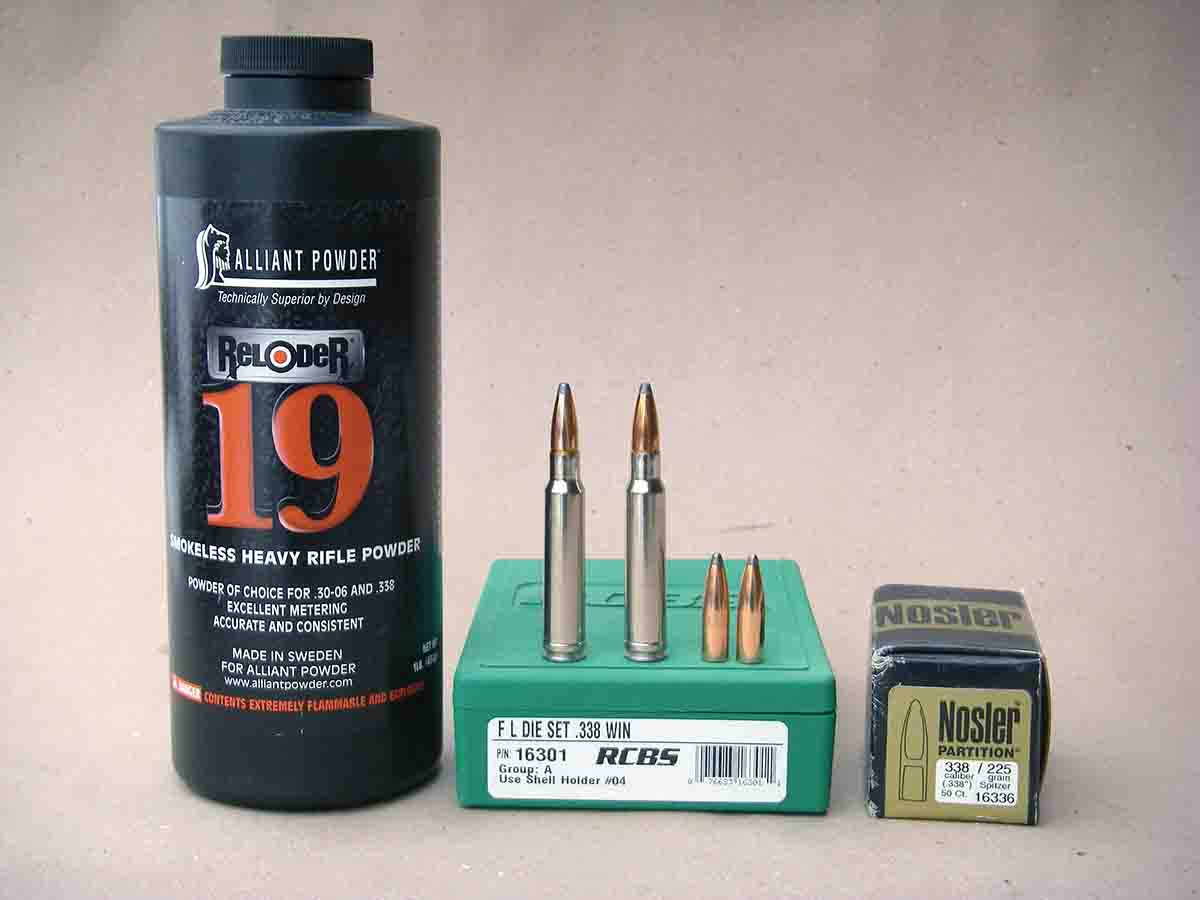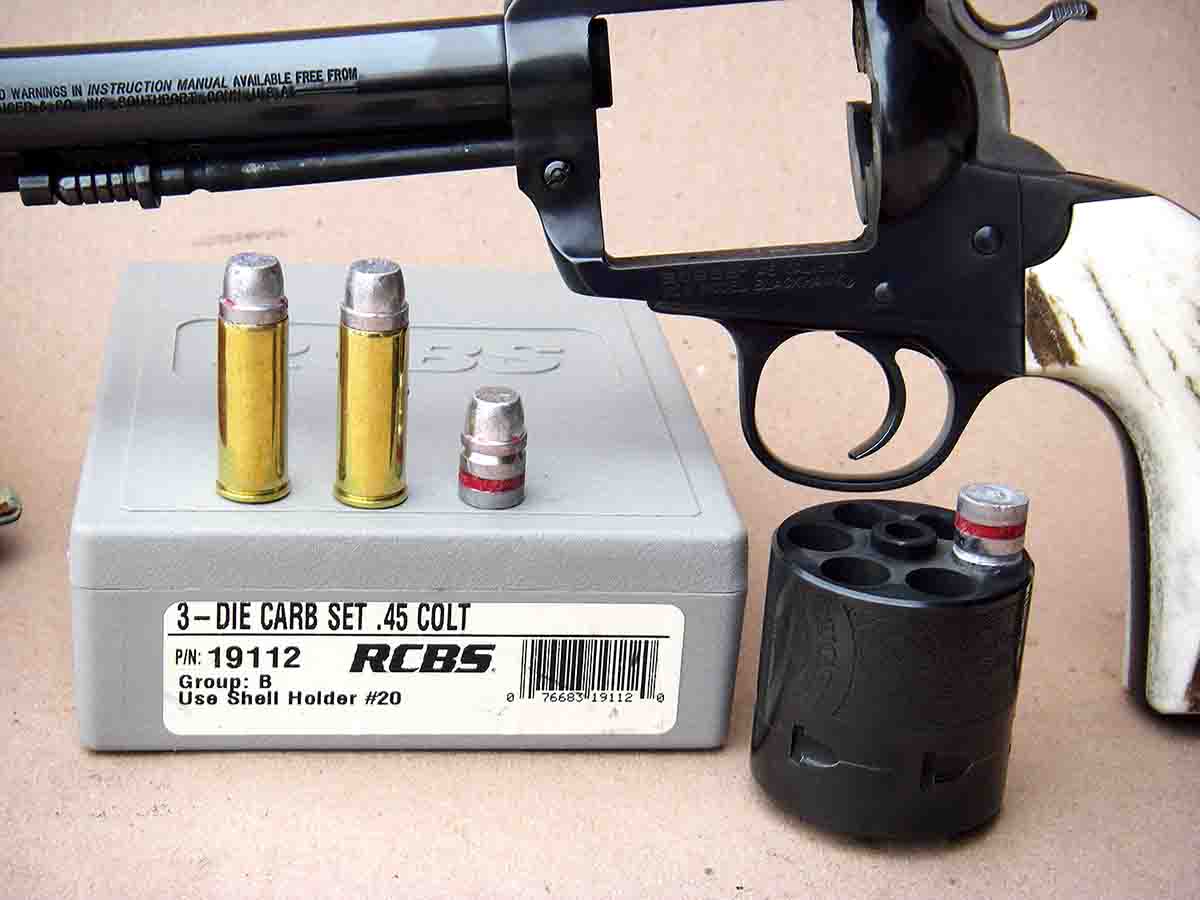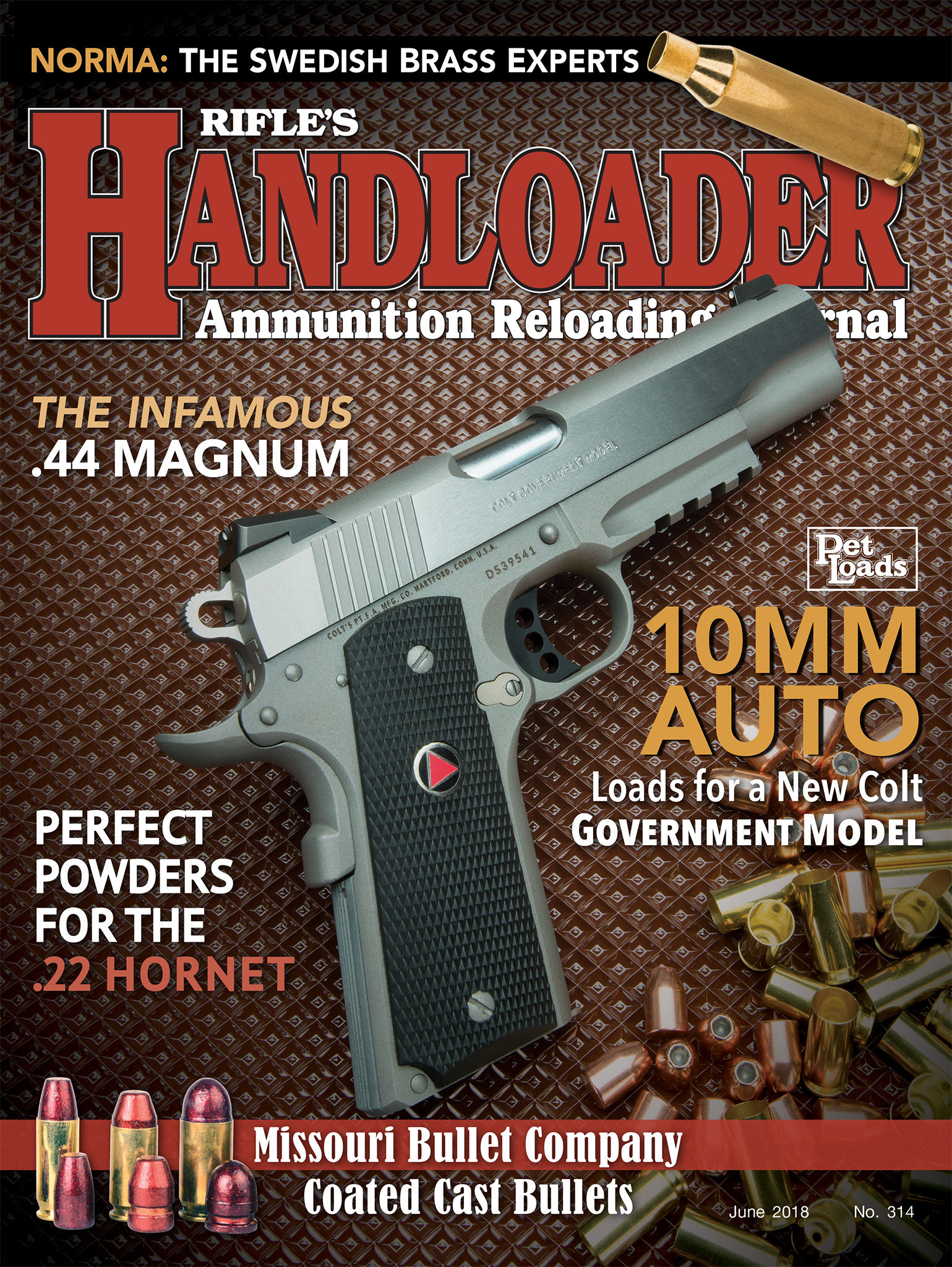Bullets & Brass
Power Pistol for the .357 and .44 Magnums
column By: Brian Pearce | June, 18

Q: You often use (and speakhighly of) Alliant Power Pistol powder in many of your revolver loads such as .38 Special, .44 Special and .45 Colt. I purchased a quantity of powder and have been very pleased with your data for those cartridges. However, I have not seen you list many loads in .357 Magnum and .44 Magnum using this powder. Can you give me maximum powder charges with the Speer 158-grain Gold Dot HP and Nosler 240-grain JHP bullets in those two cartridges? – J.J., via e-mail
A: Alliant Power Pistol is a medium burn-rate pistol powder. It thrives when loaded with standard weight bullets (for caliber) and at moderate pressures that typically fall within 12,000 to 20,000 psi. When loaded to magnum-pressure levels that typically reach 35,000 to 36,000 psi, pressure curves can become rather sharp, so maximum loads should be approached with caution.
Using the Speer 158-grain Deep Curl (formerly Gold Dot HP) .357 Magnum bullet, begin with 8.0 grains and work up to a maximum charge of 9.0 grains, which produced 1,259 fps from a Ruger GP100 with a 6-inch barrel. These loads were assembled in Starline cases with CCI 500 primers. It is very important to use a standard, nonmagnum primer or pressures will increase substantially.
Using the 240-grain Nosler JHP bullet in the .44 Magnum, start with 11.0 grains and work up to a maximum load of 12.5 grains that produced 1,210 fps from a Ruger New Model Blackhawk Bisley with 5.5-inch barrel. These loads were assembled in Starline cases with CCI 300 Large Pistol primers. Again, do not use a magnum primer or pressures will increase substantially.
.308 Marlin Express Deer Loads

Q: I am one of the lucky few that have a Marlin 308 MX levergun chambered in the .308 Marlin Express. It has the 22-inch barrel and with Hornady factory loads containing the 160-grain FTX bullet, actual velocity is just under 2,600 fps. I have a 2.8-8x 32mm Leupold VX-3 scope on it and it will regularly stay inside 1-inch at 100-yards. I have taken several Missouri whitetail deer with it, each with a single shot.
I would like to duplicate the factory loads; however, the data that I obtained is falling considerably short, as it is only pushing the Hornady 160-grain FTX bullet to 2,300 fps and is showing signs of nearing maximum pressure. Can you make suggestions as to powder choice and charge weight?
Thanks in advance. I always learn from your articles and find your data to perform exactly as you state. – V.H., Dallas, TX
A: Using the Hornady 160-grain FTX bullet, start with 41.0 grains of Hodgdon LEVERevolution powder and work to no more than 43.5 grains maximum. The above loads were developed in Hornady cases with Winchester Large Rifle primers. The 41.0-grain charge will develop around 2,400 fps while the 43.5-grain load will reach 2,600 fps.
Incidentally, I would suggest performing the seating and crimping steps as separate operations.
.338 Winchester Magnum

Q: About 20 years ago I purchased a large quantity of Federal’s Premium High Energy .338 Winchester Magnum ammunition containing a Nosler 225-grain Partition bullet that was advertised to reach over 2,900 fps. In my Winchester Model 70, that load would cut cloverleaf-size groups. I used it on many hunts, including African plains game, moose, bear and other tough, thin-skinned game. It worked very well, but unfortunately that load is no longer available from Federal. I do wonder why they discontinued it, as it worked flawlessly in my gun. Do you have any thoughts on this matter?
In those days I did not handload, but today I do and very much enjoy it. I would like to achieve the same velocity with the Nosler 225-grain bullet with my handloaded ammunition, but no one lists any data that approaches those velocities. Can you offer a formula that will allow me to duplicate it? I have asked this same question to two powder companies and they do not have any powder or data that will allow me to duplicate those loads. You are my last hope. Any information that you can provide will be greatly appreciated. – T.S., Anaconda, MT
A: I have asked Federal Cartridge why they have mostly discontinued their Premium High Energy product line, but answers were vague. I can only speculate that it was probably due to the increased pressures associated with high-performance loads. In short, most ammunition is well below industry maximum average pressure guidelines, usually at least 7 to 10 percent. The High Energy loads reduced this margin enough that some guns proved to be problematic (difficult case extraction, hard bolt lift, etc.).
The good news is that you can duplicate your desired .338 Winchester Magnum load with the Nosler 225-grain bullet. I would suggest starting with Winchester cases, as they have a larger capacity and give less pressure. Begin with 74.0 grains of Alliant Reloder 19 powder, then work up to 78.0 grains maximum, which will produce 2,930 to 2,940 fps from most 24-inch barrels. These loads were developed using Federal 215 Large Rifle Magnum primers.
.45 Colt Chamber Dimensions

Q: I recently purchased a new Ruger New Model Blackhawk chambered in .45 Colt with an extra cylinder in .45 ACP. I have been using cast bullets from RCBS mould 45-270-SAA in my Smith & Wesson, USFA SAA and Ruger Bisley with 5.5-inch barrel without problems, and always with your load data from Handloader magazine. The new gun will not chamber the round. Basically the loaded cartridges will not go deep enough into the chamber. In speaking with Ruger about the problem, they will only test fire with Winchester Super-X 250-grain RNFP bullets.
Any help that you can offer is greatly appreciated. I very much enjoy your writings and always find your information useful. – L.C., via e-mail
A: In your original letter, you listed the model number, but I was unable to verify the exact version of Ruger New Model Blackhawk that you have. I suspect that it is built on the large frame, or “.44 frame.” Many of these revolvers, but not all, had very tight chamber throats that measure .448 to .450 inch, which was a holdover measurement from the black-powder-era chamber dimensions of the Colt Single Action Army revolvers that were intentionally built with tight throats to help build pressures. Those dimensions were changed after 1900 during the smokeless-powder era. Since Ruger first introduced the Blackhawk .45 Colt in 1970, throat sizes have been all over the map. For example, during the first three or four years of production, most guns had .448- to .450-inch throats, then in the middle 1970s they were changed to around .455 to .456 inch. Around 1997 Ruger went back to the smaller throat of .448 to .450 inch for New Model Blackhawk, Bisley and Vaquero models. In 2005, with the introduction of the New Vaquero, Ruger finally did it exactly right, with most measuring .452 inch, but the larger-frame New Model Blackhawk retained the smaller throats for a period of time, while the New Model Blackhawk .45 (also in Bisley variants) built on the 50th Anniversary .357 frame size received .452-inch throats.
If your revolver has the smaller throats, the full-caliber front driving band of the RCBS 45-270-SAA bullet will not allow your cartridges to chamber, assuming bullets are sized to .452 inch, the most common size used by commercial and do-it-yourself casters.
Before concluding that the above “educated guess” is correct, I suggest trying to find the exact reason that your handloads won’t chamber. In other words, find the tight spot. If the reason is not obvious, I suggest the following procedure: Full-length size a case and make certain that it drops into your gun’s chambers without any resistance. If there is resistance, you may not have your sizer die correctly adjusted to full-length size the case. Once you know that cases are sized correctly and are chambering normally, try loading a dummy round (without powder or primer). Next, remove the cylinder and drop the dummy cartridge into the chamber. If it doesn’t fully chamber, use a brass or plastic mallet and tap it lightly until it begins to chamber more fully. (Again, do not use a loaded cartridge!) Using a punch, preferably plastic or brass, carefully tap the dummy cartridge back out of the chamber. Examine it carefully. If the tight spot is the bullet’s front driving band, you will see corresponding marks on the band. If the case is the problem, you will see scratches or a shiny spot when the cartridge is forced into the chamber.
It is possible your Ruger has a tighter chamber than your other guns, and the roll crimp could be excessive (in the form of a slight bulge), preventing proper chambering. If the cases have been fired in a levergun, sometimes there can be a slight bulge just forward of the head, and some dies will not fully remove this bulge to allow reloaded cases to chamber in guns with minimal dimension chambers.
If your revolver has undersized .448- to .450-inch throats, there are a couple of solutions. Try sizing the cast bullets to correspond with throat size. However, this will not result in top accuracy as bullets are then undersized when traveling down the barrel with around a .452-inch groove diameter. This can also cause fusion and barrel leading. The best solution is to open the throats up to .452 inch, which will decrease chamber pressures and nearly always increases accuracy. This can be done at home using a Dave Manson Precision reaming tool (mansonreamers.com) designed specifically for this task, or you can send the cylinder to a competent custom revolver smith, and for a modest fee they can open the throats.
I hope this information proves helpful and thanks for taking the time to read our magazines.


